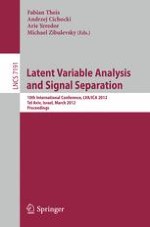This book constitutes the proceedings of the 10th International Conference on Latent Variable Analysis and Signal Separation, LVA/ICA 2012, held in Tel Aviv, Israel, in March 2012. The 20 revised full papers presented together with 42 revised poster papers, 1 keynote lecture, and 2 overview papers for the regular, as well as for the special session were carefully reviewed and selected from numerous submissions. Topics addressed are ranging from theoretical issues such as causality analysis and measures, through novel methods for employing the well-established concepts of sparsity and non-negativity for matrix and tensor factorization, down to a variety of related applications ranging from audio and biomedical signals to precipitation analysis.
